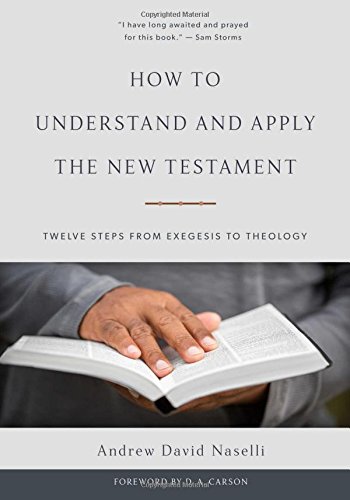A Brief Book Summary from Books At a Glance
By Benjamin Montoya
About the Author
Andrew David Naselli is an Assistant Professor of New Testament and Theology at Bethlehem College & Seminary and an elder of Bethlehem Baptist Church. He earned a Ph.D. in Historical Theology from Bob Jones University and a Ph.D. in New Testament from Trinity Evangelical Divinity School under D. A. Carson. He has written and edited several noteworthy books including The NIV Zondervan Study Bible, Conscience: What It Is, How to Train It, and Loving Those Who Differ, and From Typology to Doxology: Paul’s Use of Isaiah and Job in Romans 11:34–35.
Introduction
In this book Naselli explains his model of understanding and apply the New Testament moving from exegesis to theology. He develops a twelve-step model for interpreting Scripture. This model involves the twelve chapters that comprise this book. His hope for this book is that it will help others learn to interpret the Bible better so that they can glorify God most by being most satisfied in Him. Naselli shows the influence that John Piper has had on Naselli in outlining this larger purpose. These twelve steps are not something to be followed rigidly; rather, they are a roadmap for interpreters as they begin the process. He defines exegesis: “Exegeting the New Testament includes but is not limited to parsing Greek words, doing word studies, and analyzing syntax at various levels (i.e., clause, sentence, discourse, genre) while being sensitive to literary features and the running argument” (1). That is, when an interpreter seeks to exegete a text, they need to seek the author’s meaning, not their own.
Table of Contents
Introduction
Chapter 1 Genre
Chapter 2 Textual Criticism
Chapter 3 Translation
Chapter 4 Greek Grammar
Chapter 5 Argument Diagram
Chapter 6 Historical-Cultural Context
Chapter 7 Literary Context
Chapter 8 Word Studies
Chapter 9 Biblical Theology
Chapter 10 Historical Theology
Chapter 11 Systematic Theology
Chapter 12 Practical Theology
Conclusion
Chapter 1 : Genre
“Genre” is probably a word that we only commonly associate with types of movies we watch or music we listen to; nevertheless, this word also matters for biblical interpretation. The goal with the first step of interpretation is to “establish guidelines for interpreting a passage’s style of literature” (3). When we read modern writing, we do this intuitively; for example, we know that interpreting someone’s Facebook post is different than reading a novel. But, when it comes to ancient documents like the Bible, we should learn how to recognize these differences. In the New Testament, there are several different kinds of genres: gospel, history, letters, parables, and prophecy. Each of these genres recognizes that we learn interpretive guidelines that help us learn how to interpret them in accordance with how the author used that genre. Let’s take the parables of Christ as an example. Naselli defines the word “parable” as follows: “The word parable is remarkably flexible and can include a proverb, riddle, allegory, metaphor, or simile” (26). There are several interpretive guidelines to keep in mind: we should not assume that the events in the parable are historical, we should avoid proposing allegorical meanings that are not anchored in the text itself; we need to discern the main point(s); we ought to pay attention to the historical and literary context of the parable, and then, and only then, translate the main point of the parable into the modern-day context. Although there are certainly more principles to keep in mind for every kind of genre, these highlight how this genre should be handled carefully. Naselli provides many other guidelines for every other genre as well.
Chapter 2: Textual Criticism
The next interpretive step that Naselli recommends is textual criticism; the goal for this step is “establish the original wording” (36). As of July 2016, there are a total of 5,849 different copies of the Greek New Testament. Given that the printing press did not exist; these copies were hand-copied—thus, lots of room for typographical errors. Most of the differences do not matter because other manuscripts confirm the original wording. Nevertheless, some of them matter. Naselli recommends five steps. First, the interpreter should understand the different kinds of variants. Second, the interpreter should understand how to read the textual apparatus of the current editions of the Greek New Testament. If the reader cannot access these apparatuses, then textual criticism will prove to be nearly impossible. That is why learning the original languages still matters. Third, the interpreter, then, needs to weight the internal evidence—that is, the readings in the manuscript themselves. Fourth, the interpreter should consider the external evidence—that is, the manuscripts themselves. The tendency of text-editors was to smooth out seemingly more difficult readings and to lengthen shorter readings. Questions for this step should focus on the date and character of the manuscript, the text-type, and if the reading is geographically. . .
[To continue reading this summary, please see below....]The remainder of this article is premium content. Become a member to continue reading.
Already have an account? Sign In
